Wedding cake
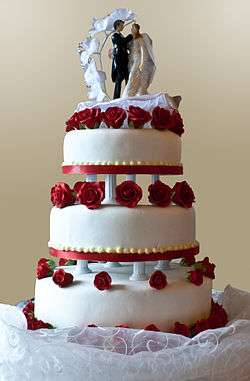 A three-layer wedding cake with pillar supports and "topper" figures | |
| Type | Cake |
|---|---|
A wedding cake is the traditional cake served at wedding receptions following dinner. In some parts of England, the wedding cake is served at a wedding breakfast; the 'wedding breakfast' does not mean the meal will be held in the morning, but at a time following the ceremony on the same day. In modern Western culture, the cake is usually on display and served to guests at the reception. Traditionally, wedding cakes were made to bring good luck to all guests and the couple. Modernly however, they are more of a centerpiece to the wedding and are not always even served to the guests. Some cakes are built with only a single edible tier for the bride and groom to share, but this is rare since the cost difference between fake and real tiers is minimal.
Basic information

Wedding cakes come in a variety of sizes, depending on the number of guests the cake will serve. Modern pastry chefs and cake designers use various ingredients and tools to create a cake that usually reflects the personalities of the couple. Marzipan, fondant, gum paste, buttercream, and chocolate are among the popular ingredients used. Cakes range in price along with size and components. Cakes are usually priced on a per-person, or per-slice, basis.[1] Prices can range from a few dollars to a few hundred dollars per-person or slice, depending on the pastry chef who is hired to make the cake. Wedding cakes and cake decorating in general have become a certain pop culture symbol in western society. In the United States, reality television shows such as Cake Boss and Amazing Wedding Cakes have become popular and are trending in today’s popular culture.
History
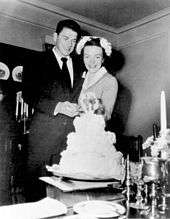
Pre-18th century history
The contemporary wedding cake has grown out of several different ethnic traditions. One of the first traditions began in Ancient Rome, where a cake of wheat or barley was broken over the bride’s head to bring good fortune to the couple.[2]
Wedding cake was originally a luxury item, and a sign of celebration and social status. The bigger the cake, the higher the social standing. Wedding cakes in England and early America were traditionally fruit cakes, often topped with marzipan and icing with tiers, Cutting the cake was an important part of the reception. White icing was also a symbol of money and social importance in Victorian times, so a white cake was highly desired.[3] Today, many flavors and configurations are available in addition to the traditional all-white tiered cake.[4]
In Medieval England cakes were stacked as high as possible for the bride and groom to kiss over. A successful kiss meant they were guaranteed a prosperous life together.[2] From this the Croquembouche was created. The myth behind this cake tells of a Pastry chef, visiting Medieval England who witnessed their tradition of piling sweet rolls between the bride and groom, which they attempted to kiss over without knocking them all down. The pastry chef then went back to France and piled sweet rolls up into a tower to make the first Croquembouche. The modern croquembouche is still very popular in France, where it is now common to place the croquembouche tower on a bed of cake and make it a top tier. This traditional French wedding cake is built from Profiteroles and given a halo of spun sugar.[5]
In 1703, Thomas Rich, a baker's apprentice from Ludgate Hill, fell in love with his employer's daughter and asked her to marry him. He wanted to make an extravagant cake, so he drew on St Bride's Church, on Fleet Street in London for inspiration.[6]
Later history
Traditionally the bride would place a ring inside the couple's portion of the cake to symbolise acceptance of the proposal.[7] During the mid-17th century to the beginning of the 19th, the “bride's pie” was served at most weddings. Guests were expected to have a piece out of politeness. It was considered very rude and bad luck not to eat the bride’s pie. One tradition of bride’s pie was to place a glass ring in the middle of the dessert and the maiden who found it would be the next to marry, similar to the modern tradition of catching the Flower bouquet. Bride’s pie would evolve into the bride’s cake. At this point the dessert was no longer in the form of a pie and was sweeter than its predecessor.[8] The bride cake was traditionally a plum or fruit cake. The myth that eating the pie would bring good luck was still common but the glass ring slowly died out and the flower bouquet toss replaced it.
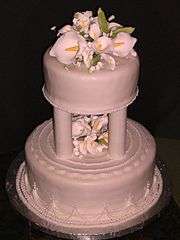
Fruit cakes were a sign of fertility and prosperity, which helped them gain popularity because married men wanted to have plenty of children. The bride’s cake would transform into the modern wedding cake we know today.[2] In the 17th century, two cakes were made, one for the bride and one for the groom. The groom's cake would die out and the bride's cake become the main cake for the event. When the two cakes were served together, the groom's cake was typically the darker colored, rich fruit cake and generally much smaller than the bride's cake. The bride’s cake was usually a simple pound cake with white icing because white was a sign of virginity and purity.[2] In the early 19th century, sugar became easier to obtain during the time when the bride’s cakes became popular. The more refined and whiter sugars were still very expensive. so only wealthy families could afford to have a very pure white frosting. This display would show the wealth and social status of the family.[9] When Queen Victoria used white icing on her cake it gained a new title, royal icing.[10]
The modern wedding cake as we know it now would originate at the 1882 wedding of Prince Leopold, Duke of Albany; his wedding cake was the first to actually be completely edible.[11] Pillars between cake tiers did not begin to appear until about 20 years later. The pillars were very poorly made from broomsticks covered in icing. The tiers represented prosperity and were a status symbol because only wealthy families could afford to include them in the cake.[2] Prince Leopold’s wedding cake was created in separate layers with very dense icing. When the icing would harden the tiers could be stacked, a groundbreaking innovation for wedding cakes at the time. Modern wedding cakes still use this method, with an added form of support with dowels imbedded in the cake to help carry the load especially of larger cakes.
Symbolism
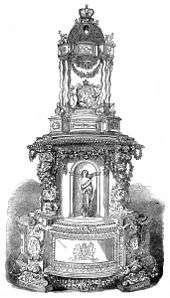
Wedding cakes have been present at wedding ceremonies for centuries. They were not always the focus of the event and often came in different forms, like pies or bread. There has always been a lot of symbolism associated with the wedding cake. The earliest known sweet wedding cake is known as a Banbury cake, which became popular in 1655.[12] The white color has been attached to wedding ceremonies since the Victorian era when Queen Victoria chose to wear a white wedding dress at her wedding to Prince Albert in 1840. Queen Victoria accentuated an existing symbol, the color white is frequently associated with virginity and purity. The wedding cake was originally known as the brides cake therefore the color white became common because the cake needed to reflect the bride.[8]
The cutting of the cake is a task full of symbolism. The cake was originally intended to be distributed among the guests by only the bride because consuming the cake would ensure fertility.[8] As weddings grew and the number of guests increased this task became a joint venture, the groom needed to help cut the growing cake and distribute it among their guests. Layers of cakes began to pile up and the icing would need to support the weight of the cake making is very difficult for one person to cut. The groom would assist the bride in this process. Once this tradition began the bride and groom would share a piece of cake before distributing it to the guests to symbolize their union and their promise to forever provide for each other.[8]
Superstitions
.jpg)
The wedding cake is surrounded by superstitions. In a traditional American wedding, maidens would be invited to pull ribbons that are attached to the bottom layer of the wedding cake.[13] Out of all the ribbons, only one contains a charm or a ring, and whoever gets the charm will be the next person to marry. In other countries, the wedding cake is broken over the bride’s head to ensure fertility and bring good fortune to the couple.[14] Also, some people today think that eating the crumbs of the wedding cake would give them good luck because the wedding cake symbolizes happiness and good life to the newlywed couple.[15]
There are also myths that most bridesmaids have on dreaming their future husbands. Hopeful bridesmaids would take a piece of cake home and place it under the pillow.[14] Some bridesmaids would sleep with the pieces of cake in their left stocking and the rest are under their pillows after passing the pieces of cake through the bride's wedding ring.[16]
In the medieval era, wedding cakes were constructed in rolls and buns that were laid on top of each other. The groom and bride would attempt to share a passionate kiss on top of the stack of rolls to ensure fertility and have good fortune. In the 18th century, newlywed couples would try to keep the cake until their first anniversary to prevent them from marriage problems in the future. This is one of the reasons why cakes in the 18th century were made of fruits and blended with wine.[17]
Types of wedding cakes
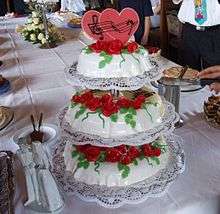

Wedding cakes come in several types, such as traditional wedding cakes, wedding cakes based on flavor, smaller cakes or individual cakes, frosted cakes, and cupcakes. Traditional wedding cakes are white, including decoration and icing varieties such as buttercream, almond. etc. Wedding cakes based on flavor include chocolate, vanilla, or strawberry. Smaller cakes or individual cakes can be more efficient in terms of price. Frosted cakes are popular due to the large amount of cream.
In modern society, the most popular wedding cake is called "traditional stack cake". This consists of layers of tiers - which can be a different flavors – positioned directly on top of the last".[18] The traditional stack wedding cake is similar to the tiered cake. Often they are filled with flowers or columns to add visual impact and height. Separators can include jewels, shells, flowers and the like or can be completely separated by using traditional chrome stands.
White cake is currently the most traditional wedding cake flavor, but different flavors of filling can be added between layers. Chocolate, carrot, Italian Rum and Italian Cream are also popular choices. Frosting can be a classic smooth surface or combined with drizzle, swirls, or chips.[19]
Fondant is a form of frosting style that is rolled out and draped over tiers. Its smooth, firm sugar icing is often embellished with appliqués, Fondant can be cut into designs, formed into shapes, flavored or tinted. Poured fondant is used to glaze petits fours and other detailed confections.
Flowerpaste or Gumpaste is a pliable dough made from egg whites, unflavored gelatine, powdered sugar, Carboximetil Cellulose(CMC) TYLOSE, or GUM tragacamthum. There are an array of methods and ingredients around the world on how to make flowerpaste/gumpaste. The purpose of this dough is to create flowers and decorations for a cake. Due to the use of gum as one of the ingredients; it can be rolled very thin.
Royal icing is made with sugar and egg white or meringue powder. It hardens to a firm finish that can be piped or thinned for "flood work". It hardens fast and is ideal for making detailed shapes ahead of time. It can also be piped directly onto cake tiers and works beautifully for delicate work.[1] a few things to consider when working with royal icing: You must use grease free utensils. Humidity also affects the consistency of royal icing. a well known British cake decorator uses royal icing as a medium, Joseph Lambeth developed a style by creating layered scrolls with Royal Icing.
In some areas, particularly South America, two cakes are presented at weddings. The more traditional tiered cake is the bride's cake, and a second flavor choice is called the "groom's cake". This tradition was brought over from England by early American colonists, who considered the white-iced "Bride's Cake" too light for masculinity. The groom's cake was usually a dark, liquor-soaked fruitcake, particularly in Virginia. Today groom's cakes are usually chocolate, although the groom often choose another of his favorite flavors. The groom's cake is usually decorated or shaped as something significant to him, such as a hobby item, sports team or symbol of his occupation. The movie Steel Magnolias features a red velvet groom's cake in the shape of a giant armadillo. The groom's cake is served at the reception as a second flavor choice for the guests, although in some regions it is served at the rehearsal dinner.
Modern adaptations
Wedding cake toppers are models or art pieces that sit atop the cake. The most common type of cake topper features a representation of a bride and groom in wedding attire. This custom was dominant in US weddings in the 1950s, where it represented togetherness.[20] Wedding toppers today are often figures that indicate shared hobbies or other passions, if they are used at all.[20] Some are humorous, or may represent the couple's hobby or occupation. Some couples use a piece of art which will be displayed in their home later, such as a statuette or Christmas ornament.[21] Some couples skip the topper altogether or decorate the top tier with flowers.
In the United Kingdom, the traditional wedding cake is made from a rich fruitcake whose ingredients last without degrading. This allowed the top tier to be stored after the wedding, to be eaten at the christening of the first child. Many modern cakes now consist of flavors such as vanilla sponge, chocolate sponge or carrot cake.
Most cakes are between three and five tiers in height. Royal wedding cakes are among the more elaborate cakes seen in the United Kingdom. Most recently in 2011, Prince William and his bride Catherine, Duchess of Cambridge, had a wedding cake that was eight tiers.[22]
See also
| Wikimedia Commons has media related to: |
Notes
- ↑ Wedding of Princess Victoria 'Vicky' (Queen Victoria's oldest child) and Crown Prince Frederick William 'Fritz' of Prussia
References
- 1 2 Stewart, M., & Kromer, W. (2007). Martha Stewart’s Wedding Cakes. New York: Clarkson Potter/Publishers.
- 1 2 3 4 5 Wilson, Carol. (2005). Wedding Cake: A Slice of History. Gastronomica: The Journal of Food and Culture 5 (2): 69-72. Retrieved 6 February 2012.
- ↑
- ↑ Different types of wedding cake. Archived 2014-09-03 at the Wayback Machine., Blog post. (2014)
- ↑ Stewart, M., & Kromer, W. (2007). Martha Stewart's Wedding Cakes. New York: Clarkson Potter/Publishers
- ↑ "London St Bride's Church inspired wedding cake tradition". Archived from the original on 2016-06-02. Retrieved 2016-05-30.
- ↑ "The History of the Wedding Cake and Cake Toppers". streetdirectory.com. Archived from the original on 2012-04-29.
- 1 2 3 4 "Archived copy". Archived from the original on 2012-04-19. Retrieved 2012-03-28.
- ↑ Tucker, Abigail. "The Strange History of the Wedding Cake". Smithsonian Magazine. Retrieved 26 November 2011.
- ↑ Wilson, Carol. (2005)."Wedding Cake: A Slice of History".(n.d). Gastronomica: The Journal of Food and Culture 5 (2): 69-72. Retrieved 6 February 2012.
- ↑ "Wedding Cakes, Loaves and Pies". Bakers Journal. Archived from the original on 2013-01-01.
- ↑ Charlsey, Simon. (1988).The wedding cake:history and meanings, Tayler&Fansis,Ltd, 99(2), 232-41.
- ↑ Gaudet, M. (2006). Ribbon Pulls in Wedding Cakes: Tracing a New Orleans Tradition. Folkshore. 117(1). p. 87-96
- 1 2 Wilson, Carol. ( 2005). "Wedding Cake: A Slice of History". Gastronomica: The Journal of Food and Culture 5 (2): 69-72. Retrieved 6 February 2012.
- ↑ Wilson, Carol.(2005). "Wedding Cake: A Slice of History". Gastronomica: The Journal of Food and Culture 5 (2): 69-72. Retrieved 6 February 2012.
- ↑ Charsley, Simon R. (1992). Wedding Cakes and Cultural History. London: Routledge. Pp. 20, 102, 108, 109. ISBN 0-415-02648-2.
- ↑ "Wedding Cakes: The Myths and Magic of Matrimony". Flash Know. Archived from the original on 2013-08-25.
- ↑ Naomi & Bruce (2009). Wedding cake types. Retrieved from: www.angelcakecompany.co.uk/wedding-cake-types.php.
- ↑ Mayntz, M. (2010)Chocolate Wedding Cakes. Retrieved from: weddings.lovetoknow.com/wiki/Chocolate_Wedding_Cakes
- 1 2 Cele Otones and Elizabeth Pleck (2003), Cinderella Dreams: The Allure of the Lavish Wedding, University of California Press, pp. 124–125, ISBN 0-520-24008-1
- ↑ "Funny Wedding Cake Toppers". Weirdomatic.com. Archived from the original on 2013-02-04. Retrieved 2012-11-16.
- ↑ Read more: http://www.dailymail.co.uk/news/article-1381944/Royal-Wedding-cake-Kate-Middleton-requested-8-tiers-decorated-900-flowers.html#ixzz4fTu3avbf Archived 2012-07-29 at Archive.is Follow us: @MailOnline on Twitter | DailyMail on Facebook
